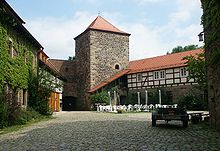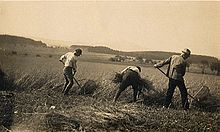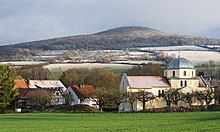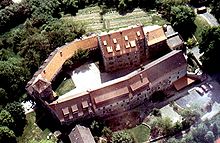Pus field
| coat of arms | Germany map | |
|---|---|---|

|
Coordinates: 50 ° 46 ' N , 9 ° 48' E |
|
| Basic data | ||
| State : | Hesse | |
| Administrative region : | kassel | |
| County : | Fulda | |
| Height : | 315 m above sea level NHN | |
| Area : | 89.83 km 2 | |
| Residents: | 7021 (Dec. 31, 2019) | |
| Population density : | 78 inhabitants per km 2 | |
| Postal code : | 36132 | |
| Primaries : | 06672
06676 (Soisdorf, Treischfeld, Ufhausen and Unterufhausen) |
|
| License plate : | FD | |
| Community key : | 06 6 31 007 | |
| LOCODE : | DE ETD | |
| Community structure: | 17 districts | |
| Address of the municipal administration: |
Fürstenecker Strasse 2 36132 Eiterfeld |
|
| Website : | ||
| Mayor : | Hermann-Josef Scheich (non-party) | |
| Location of the municipality of Eiterfeld in the district of Fulda | ||
The market town of Eiterfeld is located in East Hesse in the northern part of the Fulda district on the border with the Hersfeld-Rotenburg district and the Wartburg district in Thuringia , Germany .
geography
Geographical location
The community lies between the basalt peaks of Lichtberg , Stoppelsberg and Soisberg in the Kuppenrhön ( called Hessisches Kegelspiel in the region ). The next larger cities are Fulda about 27 km south and Bad Hersfeld about 14 km north of Eiterfeld.
The rivers Eitra and Solz arise within the municipal boundaries and flow into the Haune and the Fulda respectively .
Neighboring communities
Eiterfeld borders in the north on the communities Hauneck , Schenklengsfeld and Hohenroda (all three in the district of Hersfeld-Rotenburg ), in the east on the Thuringian community Buttlar ( Wartburgkreis ) and the community Rasdorf , in the south on the city of Hünfeld and the community Burghaun (all three in the district of Fulda), and in the west to the municipality of Haunetal (district of Hersfeld-Rotenburg).
Community structure
In addition to the core town of Eiterfeld, the community consists of the districts Arzell , Betzenrod, Buchenau , Dittlofrod, Giesenhain, Großentaft , Körnbach, Leibolz, Leimbach, Mengers, Oberweiseborn, Reckrod , Soisdorf , Treischfeld, Ufhausen and Wölf . Then there are the three hamlets of Fürsteneck, Branders and Unterufhausen .
With the exception of Wölf and Mengers as well as Buchenau and Giesenhain, which each form a common local district, a local district with a local mayor was set up for each formerly independent community.
history
"Eitrahafeldon" was first mentioned in two documents on July 18, 845, which involved an exchange of goods between King Ludwig the German and the Fulda abbot Hatto I. King Ludwig notarized the exchange of his properties in the "Eitrafeldon Marcha" for some Thuringian villages in the Königspfalz Frankfurt . The place name comes from the river Eitra, which rises on the Lichtberg. In the early Middle Ages the Eitra was called "Aeiddiraha", which translated means, for example, the rapidly rushing water .

In 1250, the northern and the southern were keep in Fürsteneck built. In 1290 Berthold von Buchenau was appointed Burgmann by Abbot Heinrich von Weilnau and the village of Fürsteneck was mentioned for the first time. During this time, there is also evidence of a central court in Eiterfeld or Fürsteneck. The Catholic St. George's Church in Eiterfeld was mentioned for the first time in 1295. From 1357, Fürsteneck Castle was the official seat of a Fulda bailiff. The castle, the court and the Fürsteneck office were pledged about a dozen times by 1532, but often quickly bought back by Fulda. During this time, Berthold von Wiesenfeld, Otto von Buchenau , the Reichsabtei Hersfeld and Hans von der Tann appeared as owners or feudal men . In 1463, Count Heinrich von Henneberg tried to conquer the castle, but this failed. In 1486 ten villages in the area around Fürsteneck belonged to the office.
The Reformation began around 1555 and Eiterfeld became Protestant until the Counter Reformation took place in 1603 . That year a Catholic pastor was installed again. Since 1603, many of today's districts belonged to the Fürsteneck office. There were the 17 towns of Arzell, Bodes, Betzenrod, Dittlofrod, Eiterfeld, Hausenmühle, Körnbach, Igelsrod (today Wüstung), Leibolz, Leimbach, Malges, Mengers, Oberufhausen , Oberweiseborn, Reckrod, Unterufhausen and Wölf.
During the Thirty Years' War the office was badly affected by the plague, among other things . The castle was destroyed after 1633. After the war, Eiterfeld only had three male residents.
On March 29, 1697, Eiterfeld received from Prince Abbot Placidus von Droste the right to hold four markets a year; the village became a market town. Between 1708 and 1710, Prince Abbot Adalbert von Schleifras rebuilt Fürsteneck Castle. In 1712 a district court building was built in Eiterfeld and the church was rebuilt from 1730 to 1731 and consecrated in 1740. The official seat moved from Fürsteneck to Eiterfeld during this time. After the secularization in 1802, the office was officially named after this place and administered itself. In October 1813 Napoleon moved through the place with his defeated army. A French grave (mass grave) is located at the foot of Fürsteneck Castle. In 1816 Eiterfeld was incorporated into the Hessian state together with the former prince-bishopric of Fulda . Eiterfeld's existing market rights were expanded on November 9, 1868 by the royal government in Kassel to include twelve pig markets a year. After the lost Prussian-Austrian war in 1866, Eiterfeld came to Prussia like all of the Electorate of Hesse . On December 1, 1906, Eiterfeld received a railway connection on the line between Hünfeld and Vacha . The electricity connection followed in 1922 and the first water pipeline was built in 1926/1927. In 1942 the Eiterfeld office was dissolved and merged with the Hünfeld office.
In today's district of Betzenrod, members of the Zionist youth organization Bachad (Brith Chaluzim Datiim - Association of Religious Pioneers), a religious-orthodox parallel organization to the Hechalutz , founded the Kibbutz Haddatih movement in 1924, which helped young Jewish people to get an agricultural education and thus to them should offer the possibility of emigration ( Aliyah ) to Palestine . With an agricultural education one could get a certificate from the British government to immigrate to Palestine. The group moved to Rodges (now part of Fulda ) in 1926/27 , but since Rodges was too small, they finally moved in 1929 to the Gehringshof near Fulda, which they had acquired and which they called Kibbutz Haddatih.
After the Second World War , Eiterfeld became Hessian again . The railway line was shut down again due to the zone boundary , initially from Treischfeld and from 1969 from Hünfeld. From 1952, for the first time since the Counter Reformation, there was a Protestant community again. Between 1952 and 1953, Otto Bartning expanded Fürsteneck Castle into a folk high school.
As part of the 1150th anniversary celebration on July 4, 1995, the municipality of Eiterfeld was granted the right to use the title of market municipality in the municipality name.
Incorporations
In the course of the regional reform in Hesse , the following previously independent municipalities were incorporated as districts on a voluntary basis : On May 1, 1970 Leibolz; Reckrod followed on September 1, 1970; on February 1, 1971 Arzell, Betzenrod, Großentaft, Körnbach, Soisdorf and Treischfeld were added; Dittlofrod and Oberweiseborn followed on April 1, 1972. The series of incorporations was completed on August 1, 1972 with the incorporation of Buchenau, Leimbach, Mengers, Ufhausen and Wölf by virtue of state law.
Population development
The following figures apply to the total of all residents in the core town and the districts .
| year | Residents |
| 1999 | 7666 |
| 2000 | 7686 |
| 2001 | 7677 |
| 2002 | 7600 |
| 2003 | 7607 |
| 2004 | 7632 |
| 2005 | 7557 |
| 2006 | 7538 |
| 2012 | 7176 |
| 2014 | 7088 |
| 2016 | 7050 |
| Source : Eiterfeld municipality | |
Religions
Catholic Church
The area of the political community Eiterfeld includes Catholic parishes , which in turn are assigned to deaneries or pastoral associations in the diocese of Fulda . You are part of the Deanery Hünfeld-Geisa .
Serbian Orthodox Church
politics
Community representation
The local elections on March 6, 2016 brought the following results, compared to previous local elections:
| Parties and constituencies |
% 2016 |
Seats 2016 |
% 2011 |
Seats 2011 |
% 2006 |
Seats 2006 |
% 2001 |
Seats 2001 |
||
|---|---|---|---|---|---|---|---|---|---|---|
| CDU | Christian Democratic Union of Germany | 42.9 | 13 | 42.6 | 13 | 38.0 | 12 | 52.3 | 16 | |
| FWG | Free community of voters | 39.0 | 12 | 34.2 | 11 | 36.9 | 11 | 26.6 | 8th | |
| SPD | Social Democratic Party of Germany | 12.9 | 4th | 15.5 | 5 | 22.1 | 7th | 18.7 | 6th | |
| GREEN | Alliance 90 / The Greens | 5.2 | 2 | 7.6 | 2 | - | - | - | - | |
| CWE | Christian voter unity | - | - | - | - | 3.0 | 1 | 2.3 | 1 | |
| total | 100.0 | 31 | 100.0 | 31 | 100.0 | 31 | 100.0 | 31 | ||
| Voter turnout in% | 64.7 | 63.8 | 78.0 | 70.3 | ||||||
mayor
Mayor Hermann-Josef Scheich, ran as a non-party candidate and was supported in previous elections by the SPD and the FWG. He is a member of the SPD. At his first re-election on March 26, 2006, he was confirmed in office with 78.4% of the votes. His challenger Stefan Schubert ( CDU ) received 21.6%. In his second re-election on March 1, 2012, he was the only candidate with a voter turnout of almost 50 percent and 89.4 percent approval. On March 4, 2018, Sheikh was elected for a fourth term with 72.5%.
coat of arms
The coat of arms was awarded to the place by the state of Hesse when it became the capital of the new large community in 1972.
The nine stylized lilies at the top left and the eight at the bottom right (all silver on red) symbolize the 17 places of the large community. The lower left field with the old Fulda cross (black on silver) indicates that the places belonged to the prince abbey from their foundation until 1802. The silver crowned green bird with a silver collar in the golden field at the top right is a parakeet, the heraldic animal of the Knights of Buchenau , which survived as the only noble family in our area from the earliest times to modern times. The coat of arms is square in red and gold or silver. Nine silver lilies in red in the upper right corner and eight silver lilies in red in the lower left corner. In silver a black continuous cross in the lower right corner and in gold a silver crowned green bird with a silver collar in the left upper field.
Community partnerships
Culture and sights
Buildings
- Fürsteneck Castle (from approx. 1250)
- Buchenau Castle (Renaissance castle from 1618)
- Soisdorf church with military cemetery
- Soisberg observation tower
- Eitraquelle (light mountain)
Natural monuments
The dinosaur tracks from Eiterfeld are located in a disused and filled sandstone quarry near Körnbach. It is a recognized ground monument according to the Hessian Monument Protection Act and is 240 million years old. It is the most important continuous track record of chirotheria (hand animals), the forerunners of the dinosaurs.
Sports
- Eiterfeld bathing park
- Sports field at the grove
- Tennis court
- Tennis hall
Economy and Infrastructure
Numerous companies are represented in Eiterfeld. Larger employers known beyond the region are e.g. B. the Giebel group of companies (construction company, forwarding agent and quarry), b + m surface systems GmbH (painting systems, surface technology), Maschinenbau Karl Ley GmbH & Co KG (plant and apparatus construction), Ebner GmbH & Co. KG ( Plant and apparatus engineering), a branch of Ondal Industrietechnik GmbH (medical / industrial technology), Boart Longyear GmbH & Co. KG (drilling systems).
traffic
Eiterfeld is connected to the supra-regional transport network via various country roads. Above all, they create the connection to the federal highway 27 , which leads past the municipality to the west.
The Public transport is by the Rhine-Main Transport Association guarantees (RMV). The bus routes are operated by a subsidiary of RhönEnergie Fulda .
The Hünfeld – Wenigentaft – Mansbach railway had a station in Eiterfeld from December 1, 1906 to May 28, 1972. The 27 km long skittles cycle path has been running on the route since 2007 .
education
- Lichtbergschule Eiterfeld (comprehensive school)
- Elementary school Eiterfeld
- Großentaft primary school
- Academy for professional and musical-cultural further education Burg Fürsteneck
Personalities
Sons and daughters of the church
- Wunibald Braun (1839–1912), industrialist, co-founder of the measurement and control technology company Hartmann & Braun AG
- Bonifatius Sauer (1877–1950), Missionary Benedictine , Abbot Bishop , Martyr of Tokwon
- Günter Scheich (* 1956), psychotherapist and writer
- Patrick Spies , (1979 *) Cooking with a star in the Michelin guide awarded
Honorary citizen
- Eusebius Breiten (* 1884 in Großentaft, † 1969 in Sapporo),
- Franciscan Father, Professor of Philosophy and Latin
- Awarded in the year ???
- 59 years in the Japan mission, he translated the Bible into Japanese and created the German-Japanese dictionary
- Eduard Krieg (* 1911 in Großentaft; † 2011 in Fulda),
- Prelate, senior teacher
- Awarded in 2005
- Decades of work for the social environment in his home community
literature
- Michael Mott : The tour of the suffering was over for us / Are the "French graves" from the Retirade in 1813 forgotten? Today there are memorials against the war (example "Franzosengrab" at the foot of Burg Fürsteneck). Fuldaer Zeitung, February 28, 1991, p. 12 (series: DENK-mal!).
- Rudolf Christl (Ed.): 1150 years village and market Eiterfeld - Office and court Fürsteneck 845–1995. Published in 1995 on behalf of the municipality of Eiterfeld. 542 pages with numerous illustrations and documents.
Web links
- Internet presence of the market town of Eiterfeld
- Eiterfeld, District of Fulda. Historical local dictionary for Hessen. In: Landesgeschichtliches Informationssystem Hessen (LAGIS).
- Link catalog on the subject of pus field at curlie.org (formerly DMOZ )
- Jewish history in Eiterfeld
Individual evidence
- ↑ Hessian State Statistical Office: Population status on December 31, 2019 (districts and urban districts as well as municipalities, population figures based on the 2011 census) ( help ).
- ↑ Mayor - Eiterfeld community
- ^ Sources: Heinz-Jürgen Hoppe: From Betzenrod to Kibbutz Rodges. Religious-Zionist Chaluz work in the Fulda area. In: Buchenblätter Vol. 62, 1989; - Erhard Lotter: The Gehringshof in the period from 1922-48: a contribution to the thousand-by-thousand-piece puzzle of a Zionist Hachschara site near Fulda , in: Contributions to the history of Neuhof , Volume 3, Geschichtskreis Neuhof, 2005, pp. 287-302; - Y. Walk: "The Torah va-Avoda Movement in Germany", In: Leo Baeck Yearbook 6 , 1961; - Aryei Fishman: Judaism and Modernization on the Religious Kibbutz (Chapter 4: "The foundations of the Religious Kibbutz Movement"), Bar-Ilan University, Israel, 1992, (Online Publication: October 2009), Online ISBN 978-0-511-55733-0 , Hardback ISBN 978-0 -521-40388-7 , paperback ISBN 978-0-521-05027-2
- ↑ Incorporation of the Leibolz community into the Eiterfeld community, Hünfeld district from April 27, 1970 . In: The Hessian Minister of the Interior (Ed.): State Gazette for the State of Hesse. 1970 No. 20 , p. 13 , point 807 ( online at the information system of the Hessian state parliament [PDF; 5,8 MB ]).
- ↑ Incorporation of the Reckrod community into the Eiterfeld community, Hünfeld district on August 17, 1970 . In: The Hessian Minister of the Interior (Ed.): State Gazette for the State of Hesse. 1970 No. 35 , p. 1697 , point 1586 ( online at the information system of the Hessian state parliament [PDF; 4.8 MB ]).
- ↑ Law on the reorganization of the districts of Fulda and Hünfeld and the city of Fulda (GVBl. II 330-14) of July 11, 1972 . In: The Hessian Minister of the Interior (ed.): Law and Ordinance Gazette for the State of Hesse . 1972 No. 17 , p. 220 , § 17 ( online at the information system of the Hessian state parliament [PDF; 1,2 MB ]).
- ^ Federal Statistical Office (ed.): Historical municipality directory for the Federal Republic of Germany. Name, border and key number changes in municipalities, counties and administrative districts from May 27, 1970 to December 31, 1982 . W. Kohlhammer GmbH, Stuttgart / Mainz 1983, ISBN 3-17-003263-1 , p. 399 and 400 .
- ^ Result of the municipal election on March 6, 2016. Hessian State Statistical Office, accessed in April 2016 .
- ^ Hessian State Statistical Office: Result of the municipal elections on March 27, 2011
- ^ Hessian State Statistical Office: Result of the municipal elections on March 26, 2006
- ↑ Report on the appointment on the community website (accessed on January 20, 2014)
- ↑ Non-profit interest group Saurierspuren Eiterfeld e. V.
- ↑ http://www.cvz-buchonia.de/Presse.htm (see December 2, 2005 "Cbr. Prelate Dr. Eduard Krieg (PM, Ad) - honorary citizen of Eiterfeld")









